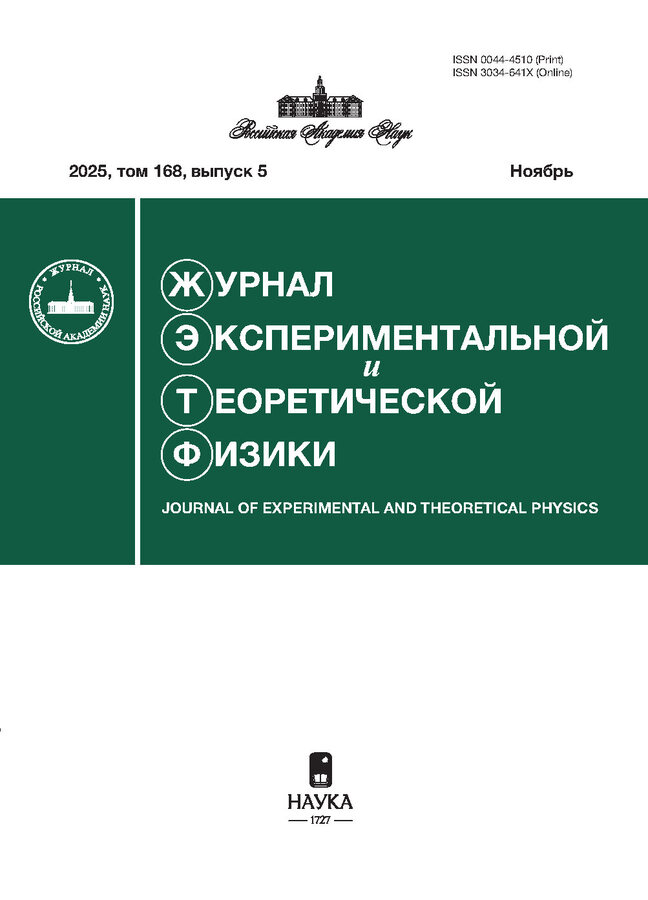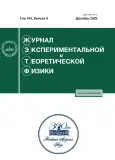Quasilinear Simulation of the Development of Weibel Turbulence in Anisotropic Collisionless Plasma
- Authors: Kuznetsov A.A.1, Nechaev A.A.1, Garasev M.A.1, Kocharovskiy V.V.1
-
Affiliations:
- Institute of Applied Physics, Russian Academy of Sciences
- Issue: Vol 164, No 6 (2023)
- Pages: 1098-1119
- Section: Articles
- URL: https://journals.rcsi.science/0044-4510/article/view/247372
- DOI: https://doi.org/10.31857/S0044451023120210
- EDN: https://elibrary.ru/MYQYLX
- ID: 247372
Cite item
Full Text
Abstract
A spectral quasilinear approach to the problem of TEM-Weibel instability in an anisotropic collisionless plasma is developed, which takes into account only the integral nonlinear interaction of modes through the joint variation of the spatially averaged particle velocity distribution induced by these modes. Within this approximation, a closed system of equations is obtained for the one- and two-dimensional evolution of spatial modes (harmonics) of the distribution function of particles and the electromagnetic field under conditions when the plasma anisotropy axis, the wave vector, and the magnetic field of the modes are orthogonal to each other. The numerical solution of this system of equations is compared with the available results of one-dimensional analytical quasilinear theory in the region of its applicability, as well as with the results of two-dimensional simulation by the particle-in-cell method, which also takes into account the direct four-wave interaction of modes. It is established that in the simplest cases of one-dimensional and axially symmetric two-dimensional problems for a bi-Maxwellian plasma, quasilinear phenomena play the leading role at a quite long stage of nonlinear development of turbulence. It is noted that at a later stage of decay of turbulence and in a more general formulation of the problem, in particular, in the presence of an external magnetic field, the direct nonlinear interaction of modes can manifest itself along with quasilinear phenomena. Based on the analysis carried out, the contribution of certain nonlinear effects to the evolution of the spatial spectrum of Weibel turbulence is revealed, and the properties of this turbulence are studied, including the self-similar character and qualitatively different stages of the dynamics of unstable modes.
About the authors
A. A. Kuznetsov
Institute of Applied Physics, Russian Academy of Sciences
Email: kuznetsov.alexey@ipfran.ru
603950, Nizhny Novgorod, Russia
A. A. Nechaev
Institute of Applied Physics, Russian Academy of Sciences
Email: kuznetsov.alexey@ipfran.ru
Institute of Applied Physics, Russian Academy of Sciences
M. A. Garasev
Institute of Applied Physics, Russian Academy of Sciences
Email: kuznetsov.alexey@ipfran.ru
603950, Nizhny Novgorod, Russia
Vl. V. Kocharovskiy
Institute of Applied Physics, Russian Academy of Sciences
Author for correspondence.
Email: kuznetsov.alexey@ipfran.ru
603950, Nizhny Novgorod, Russia
References
- А. Б. Михайловский, Теория плазменных неустойчивостей, Атомиздат, Москва (1971).
- Н. Кролл, А. Трайвелпис, Основы физики плазмы, Мир, Москва (1975).
- T. N. Kato, Phys. Plasmas 12, 080705 (2005).
- L. V. Borodachev and D. O. Kolomiets, J. Plasma Phys. 77, 277 (2010).
- C.Ruyer et al., Phys. Plasmas 22, 032102 (2015).
- M. Lazar et al., Front. Astron. Space Sci. 8, 77559 (2022).
- Л. В. Бородачев и др., Изв. вузов. Радиофизика 59, 1107 (2016).
- D. V. Romanov et al., Phys. Rev. Lett. 93, 215004 (2004).
- W. Baumjohann and R. Treumann, Basic Space Plasma Physics, Imperial College Press, London (2012).
- R. A. Treumann, Astron. Astrophys. Rev. 17, 409 (2009).
- A. Marcowith et al., Rep. Prog. Phys. 79, 046901 (2016).
- S. P. Gary, Theory of Space Plasma Microinstabilities, Cambridge Univ. Press, Cambridge (1993).
- E. S. Weibel, Phys. Rev. Lett. 2, 83 (1959).
- M. Zhou et al., Proc. Natl. Acad. Sci. USA 119, e2119831119 (2022).
- B. D. Fried, Phys. Fluids 2, 337 (1959).
- G. Kalman, Phys. Fluids 11, 1797 (1968).
- R. L. Morse and C. W. Nielson, Phys. Fluids 14, 830 (1971).
- В. В. Кочаровский и др., УФН 186, 1267 (2016).
- M. Lazar, R. Schlickeiser, and P. K. Shukla, Phys. Plasmas 13, 102107 (2006).
- A. Stockem, M. E. Dieckmann, and R. Schlickeiser, Plasma Phys. Control. Fusion 51, 075014 (2009).
- U. Schaefer-Rol s, I. Lerche, and R. Schlickeiser, Phys. Plasmas 13, 012107 (2006).
- A. A. Kuznetsov et al., Plasma Phys. Rep. 48, 973 (2022).
- M. V. Medvedev et al., Astrophys. J. 618, L75 (2005).
- G. Chatterjee et al., Nat.Commun. 8, 15970 (2017).
- K. Y. Vagin and S. A. Uryupin, Plasma Phys. Rep. 40, 393 (2014).
- O. A. Pokhotelov and O. A. Amariutei, Ann. Geophys. 29, 1997 (2011).
- R. C. Davidson, Phys. Fluids 15, 317 (1972).
- М. А. Гарасев, Е. В. Деришев, Изв. вузов. Радиофизика 60, 1040 (2017).
- M. A. Garasev and E. V. Derishev, Radiophys. Quantum El. 63, 909 (2021).
- T. D. Arber et al., Plasma Phys. Control. Fusion 57, 113001 (2015).
- А. А. Веденов, Квазилинейная теория плазмы, Атомиздат, Москва (1962).
- C. K. Birdsall and A. B. Langdon, Plasma Physics via Computer Simulation, CRC Press (2018).
- A. A. Nechaev, A. A. Kuznetsov, and V. V. Kocharovsky, J. Plasma Phys. 89, 175890601 (2023), doi: 10.1017/S0022377823001198.
- А. А. Нечаев и др., Изв. вузов. Радиофизика 62, 932 (2019).
- V. M. Vasyliunas, J. Geophys. Res. 73, 2839 (1968).
- M. Lazar, R. Schlickeiser, and S. Poedts, Phys. Plasmas 17, 062112 (2010).
- G. Livadiotis, Kappa Distributions: Theory and Applications in Plasmas, Elsevier (2017).
- G. Livadiotis, G. Nicolaou, and F. Allegrini, Astrophys. J. Suppl. Ser. 253, 16 (2021).
- V. Pierrard and M. Lazar, Sol. Phys. 267, 153 (2010).
- S. M. Shaaban et al., Astrophys. J. 918, 37 (2021).
- S. M. Shaaban et al., Mon. Not. Roy. Astron. Soc. 483, 5642 (2019).
- P. H. Yoon, Rev. Mod. Plasma Phys. 1, 4 (2017).
- M. E. Dieckmann et al., Plasma Phys. Control. Fusion 61, 085027 (2019).
- A. Stockem Novo et al., Phys. Plasmas 22, 092301 (2015).
Supplementary files










